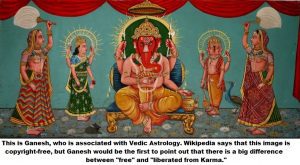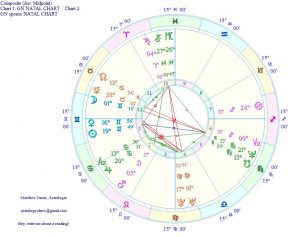Imagine for a moment that Western astrology and Vedic astrology are two separate camps located near each other out in the woods. They engage in largely the same practices, but each camp has their own particular spin on thing and speaks in their own special dialect. For the most part though they tend to ignore each other.
Then one night each camp decides to send another spy over to the other one to listen in on their conversations, to see what they could learn from the experience the other group is having.
The next morning the Vedic spy returns to his camp, smiling. “I’ve got good news folks! There is this thing we aren’t using called the Midheaven, and it’s fantastic for stuff like career planning!”
The Western spy returns to his camp and sits down on the ground and rests his face in his hands, looking miserable. “Bad news, people. I’ve just discovered something else terrible that Saturn does…”
***
You’ve got to be careful when translating Vedic concepts into Western astrology and vice versa. Many techniques from one system can work in the other system, but as any professional translator can tell you certain subtleties in one language are hard to convey in another. I’m reminded of an early experiment in computer translation where the English phrase “the spirit is willing, but the flesh is weak” was translated into Russian. The Russian translation came out as saying “the meat is good, but the alcohol is diluted.” This is the sort of thing that can happen when you translate Vedic astrology concepts into the Western system: not only will meaning be lost, if poorly done you’ll come across as just plain stupid.
If you are into Western astrology but want to learn more Vedic, I encourage you to keep the charts and the observations you make separate from each other. Both can be surprisingly accurate, but they speak essentially different languages. You can describe yourself in terms of your height, weight, build, hobbies, and occupation — or you can describe yourself as a carbon-based bipedal hominid who requires an oxygen-nitrogen atmosphere, dihydrogen monoxide, and a temperature range of between 280-300 degrees Kelvin. Both of these descriptions would be entirely accurate, but one is best suited to a dating profile, and the other one is best when first communicating with the Ambassador from Planet Zoolak… otherwise you’ll just sound weird and won’t get the results you were looking for.
I’ve had just enough experience with Vedic astrology that I wouldn’t necessarily bill myself as a Vedic astrologer, but I’ve learned enough to know which concepts import well and which ones don’t. On occasion here I will be presenting certain Vedic concepts that are particularly useful alongside Western techniques. I’ve already written one such blog entry, and you can see it here.
I’ve taught Western astrology before, and whenever the subject of Vedic comes up I encourage my students to learn more with the joke/warning that “if you are learning Vedic astrology and having fun with it, you’re probably doing it wrong.” Vedic tends to come across a lot more pessimistic than Western astrology does. It isn’t really, but both Western in Vedic astrology have distinctive you points on The Human Condition call me and to a Westerner that can often come across as gloomy.
Just relax. I will attempt to make this as enjoyable and painless as possible. Keep that in mind when you read the next sentence.
NEXT TIME: Sade Sati… the other awful thing Saturn does to you.



